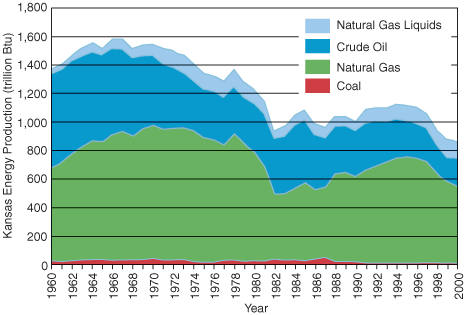| Kansas Geological Survey | Fall
2003 |
Vol.
9.3 |
|
Kansas Energy
CONTENTS Kansas Energy–page 1 |
Gasoline prices, blackouts, and the threat of high natural gas prices this winter have many Kansans concerned about energy. As the state’s energy picture continues to change, all Kansans will be affected by the accompanying environmental and economic issues. For much of its history, Kansas was an exporter of energy. That is, it produced more energy than it consumed. Since 1997, however, the state has consumed more energy than it has produced. Primarily because of declining production in the state’s oil and gas fields and increasing demand for electricity, the state now imports over half its energy. The shift to energy importer affects state revenues and jobs. Taxes on energy products, companies, royalty owners, and employees contribute significantly to the Kansas economy and help support such infrastructure as schools and roads. Energy industries provide jobs and income in many areas of the state—especially rural areas where jobs tend to be scarce. These benefits, and the people associated with these industries, will leave the state if energy is produced elsewhere. Historically, oil and natural gas, and to a lesser degree coal, have been the state’s main sources of energy. The largest natural gas field in North America, the Hugoton natural gas area, is in southwestern Kansas, and numerous oil and gas producing areas are scattered over much of the state. But most of this production was developed in the early and middle 1900’s, and it is now reaching the end of its normal productive life. Oil production is about a third of what it was in 1960, and natural gas production about half. Still, Kansas remains one of the top ten oil- and natural gas-producing states in the country. Kansas coal was an important energy source during the development of railroading and the EuroAmerican settlement of the state during the late 1800’s. With the advent of stricter environmental regulations in the 1970’s, high-sulfur Kansas coal became less desirable and was replaced with cleaner-burning, low-sulfur coals from western states such as Wyoming and Colorado. Today, only one small mine operates near Prescott in Linn County. Ironically, coal consumption in Kansas has increased significantly since the 1970’s, with the construction of coal-fired electrical-generating plants that import western coal, contributing to the state’s energy deficit. However, not all the production news is bad. Different production methods and new energy sources are being developed in Kansas. Although many of the state’s oil fields are near the end of their economic lives, they still contain considerable oil. A new method to recover additional oil from some of these fields, called carbon dioxide flooding, is being tested in central Kansas (see related story on page 3). Basically, the method involves pumping carbon dioxide into an existing oil reservoir, where it pushes trapped oil, left behind by conventional recovery methods, toward producing wells and is pumped to the surface. Researchers think this process, if successful, could greatly expand the lives of these oil fields. |
Kansas total energy production
peaked in 1967. |
 |
|
|
In eastern Kansas, coal is making a comeback because of the natural gas it contains. Called coalbed methane, the gas is extracted by conventional oil-and-gas drilling and production methods from coal seams found in the subsurface. Until now, most of the activity has been in southeastern Kansas, but other parts of eastern Kansas that are underlain by coal beds are seeing increased exploration for coalbed methane, especially with higher natural gas prices. Wind is the newest energy source being developed in Kansas, and the first renewable resource to produce significant amounts of electricity. Kansas ranks third in the nation for wind energy potential. Since the first commercial wind farm was completed in Gray County in 2001, interest has spread to other sites across the state. The Gray County facility has 170 wind generators distributed over nearly 12,000 acres (only about 46 total acres are actually occupied, the rest is still farmed), and at full capacity, they can generate enough electricity to power about 33,000 households. Recently, developers have focused on the Flint Hills in east-central Kansas. Unlike the vast stretches of farmland in western Kansas where wind farms are generally welcomed, the environmentally sensitive Flint Hills have seen stiff opposition to wind-farm development. As new sources of energy are being considered and developed, Kansans will have to balance environmental concerns with concerns about energy availability and revenue. It won’t be easy, but it can’t be avoided. |
| Online December 12, 2003 Comments to: lbrosius at kgs.ku.edu Kansas Geological Survey URL:http://www.kgs.ku.edu/Publications/GeoRecord/2003/vol9.3/Page1.html |